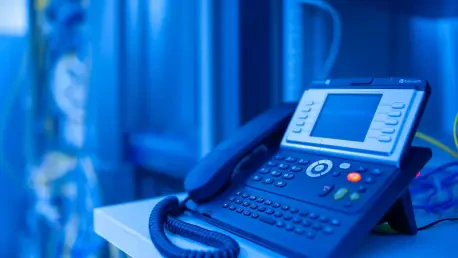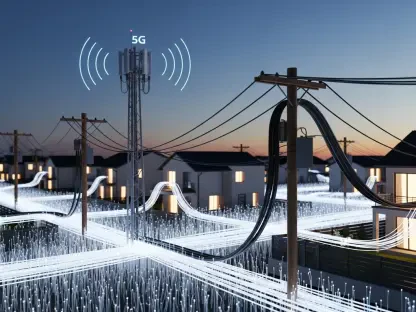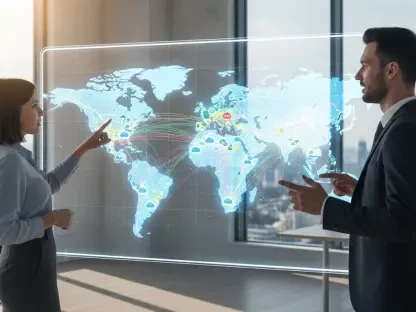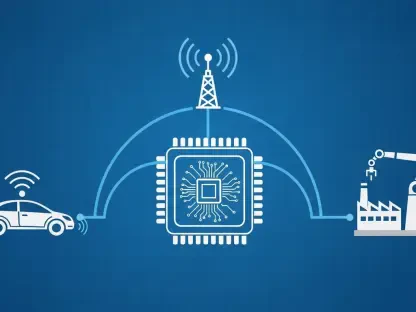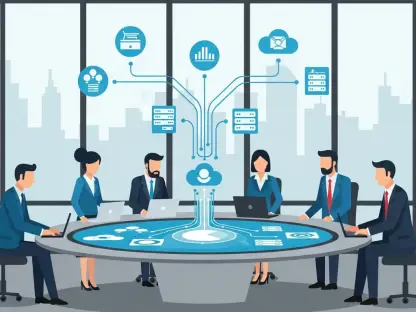In a remarkable feat of security prowess, the U.S. Secret Service recently exposed and dismantled a sprawling illicit telecommunications network lurking near the United Nations headquarters in New York City, a discovery that unfolded during the high-stakes environment of the UN General Assembly. With nearly 150 world leaders converging for this pivotal event, the potential for any disruption carried grave implications for global diplomacy and public safety. This alarming find—a sophisticated digital threat capable of paralyzing the city’s communication infrastructure—casts a stark light on the shifting nature of security challenges in densely populated urban centers. The operation not only averted a possible crisis but also revealed the urgent need to address invisible dangers that can strike without warning, blending the realms of cybersecurity and national defense in unprecedented ways.
Unveiling the Threat
Discovery and Scale
The U.S. Secret Service’s operation began as a routine protective measure but soon uncovered a staggering illicit telecom network nestled within a 35-mile radius of the UN headquarters in Manhattan. Comprising over 300 SIM servers and more than 100,000 active SIM cards, this system was no small-scale scam but a formidable tool for digital sabotage. Its capabilities included jamming cell towers, disrupting emergency 911 services, and flooding networks with millions of text messages in mere minutes. Such power could easily overwhelm New York City’s communication grid, creating chaos on an unimaginable scale. The sheer scope of this setup, hidden in plain sight near one of the world’s most iconic diplomatic hubs, raised immediate red flags about the audacity and intent behind its creation. This discovery underscored a chilling reality: digital threats can rival physical attacks in their potential to destabilize critical infrastructure.
Beyond the raw numbers, the technical sophistication of this network pointed to a deliberate and calculated design far beyond typical fraud schemes. Each SIM server acted as a mock cellphone, generating artificial traffic and enabling encrypted communications that could disguise identities and obscure malicious activities. The potential to manipulate or cripple cellular systems at will presented a direct threat to public safety, especially in a city as reliant on constant connectivity as New York. Imagine emergency responders unable to coordinate during a crisis or citizens cut off from vital information—these scenarios highlight the catastrophic possibilities that Secret Service agents confronted. This operation’s scale revealed a new dimension of vulnerability, emphasizing that urban security must now account for unseen digital battlegrounds as much as physical ones.
Timing and Context
The timing of this discovery during the UN General Assembly amplified its significance, as the event annually transforms New York into a focal point of international attention and vulnerability. Hosting nearly 150 global leaders, the assembly demands airtight security measures, making the presence of a disruptive telecom network nearby particularly alarming. While no concrete evidence has linked the network to a specific plot against the gathering, the mere possibility of interference during such a critical moment sent shockwaves through security circles. A communication blackout, reminiscent of disruptions during historic crises like 9/11, could have magnified the impact of any concurrent emergency, sowing panic and hampering response efforts. This context elevated the Secret Service’s mission from routine to urgent, spotlighting the intersection of digital threats and high-profile global events.
Moreover, the potential ramifications of a disrupted communication system during this period extend beyond immediate safety concerns to the broader sphere of international relations. A breakdown in connectivity could undermine diplomatic communications, delay critical decisions, or even exacerbate misunderstandings among nations at a time when clarity is paramount. The UN General Assembly serves as a platform for dialogue and resolution, and any interference—digital or otherwise—risks derailing delicate negotiations or crisis management. The Secret Service’s swift action in identifying this threat during such a sensitive window demonstrated not only tactical foresight but also an understanding of the cascading effects a digital attack could unleash. This incident serves as a stark reminder that modern security must anticipate disruptions in both physical and virtual spaces, especially when the world’s eyes are watching.
Investigation and Implications
Organized Operation
Delving into the investigation, the Secret Service uncovered evidence of a highly organized and well-funded operation behind the illicit telecom network, suggesting involvement from entities with substantial resources. Suspicions point toward foreign nation-states, organized crime syndicates, or even terrorist groups, given the financial and logistical demands of constructing such a complex system. Special Agent in Charge Matt McCool emphasized that the infrastructure’s sophistication implied a broader, more sinister agenda beyond mere profit or petty crime. The ongoing forensic analysis, akin to sifting through data from 100,000 individual cell phones, illustrates the monumental challenge of tracing communications and pinpointing the perpetrators. This painstaking process reflects the shadowy nature of digital threats, where culprits can operate remotely and leave minimal footprints, complicating accountability.
Further insights from the investigation revealed multiple clandestine sites across Manhattan where servers and SIM cards were stockpiled, hinting at plans for even greater expansion of the network. The discovery of these hidden locations underscored the operation’s scale and the meticulous planning involved, as each site was strategically positioned to maximize disruption potential. The resources required for such an undertaking—both in terms of technology and operational secrecy—suggest a level of coordination typically associated with sophisticated adversaries. As forensic teams continue to unravel the data, the focus remains on identifying communication patterns that could lead to the masterminds, whether they are based domestically or abroad. This case exemplifies the evolving nature of threats facing national security, where digital warfare demands as much attention and expertise as traditional espionage or physical attacks.
Urban Cybersecurity Challenges
The incident near the UN headquarters has thrust urban cybersecurity into the spotlight, exposing the fragility of digital infrastructure in modern cities like New York. With daily operations, emergency services, and public safety heavily dependent on reliable communication networks, the ability of a malicious system to trigger a blackout at will represents a profound risk. Unlike physical attacks that leave visible scars, digital disruptions can silently cripple a metropolis, halting everything from traffic management to hospital communications without a single shot fired. Special Agent McCool warned of the catastrophic consequences if such a network were activated during a public scare or coordinated attack, painting a grim picture of a city cut off from itself. This vulnerability demands a rethinking of how urban centers prepare for and defend against threats that lurk in the virtual realm.
Compounding this challenge is the sheer connectivity of urban environments, where millions of devices and systems are interlinked, creating countless entry points for exploitation. The illicit network’s capacity to jam 911 services alone could delay life-saving responses, while flooding networks with spam could overwhelm legitimate communications, sowing confusion among residents and officials alike. Addressing these risks requires not only technological solutions but also a cultural shift toward prioritizing cybersecurity at all levels of city planning and governance. Federal, state, and local agencies must collaborate to develop robust detection mechanisms and rapid response protocols tailored to digital threats. This incident serves as a critical lesson that the invisible infrastructure underpinning urban life is as vital—and as vulnerable—as its physical counterpart, necessitating urgent investment and innovation.
Secret Service’s Role and Future Concerns
Proactive Measures
The Secret Service’s decisive role in neutralizing this telecom threat near the UN headquarters highlights its evolving mission to combat digital dangers alongside traditional physical security responsibilities. Initially launched as part of protective efforts for senior U.S. officials attending the UN General Assembly, the operation swiftly pivoted to address the alarming discovery of a network poised for widespread disruption. Agents meticulously located and dismantled multiple hidden sites stocked with servers and SIM cards, preventing what could have been a devastating blow to New York’s communication systems. Director Sean Curran reiterated the agency’s unwavering commitment to preempting imminent threats, whether they manifest in the physical world or the digital domain. This proactive stance not only averted a potential catastrophe but also set a precedent for how security forces must adapt to multifaceted challenges in an interconnected era.
Beyond the immediate takedown, the Secret Service’s approach demonstrated a blend of tactical precision and strategic foresight, recognizing that digital threats can have ripple effects as severe as any physical attack. The operation required coordination with technical experts to understand the network’s capabilities and disable it without triggering unintended disruptions. This success story underscores the agency’s expanded skill set, incorporating cybersecurity expertise into its protective arsenal to safeguard national interests. By addressing the threat before it could be weaponized, the Secret Service reinforced its role as a guardian of both tangible and intangible assets critical to public safety. This incident illustrates the importance of agility in security operations, where anticipating and neutralizing invisible dangers is becoming as crucial as responding to overt threats, shaping the future of protective strategies.
Lingering Threats
Despite the triumph of dismantling this particular network, a sobering concern lingers about the potential existence of similar undetected systems in other U.S. cities. Special Agent McCool cautioned against assuming this was an isolated case, suggesting that other urban centers could harbor comparable threats waiting to be exploited. The scale and stealth of the Manhattan operation indicate that adversaries may already have embedded digital weapons in strategic locations nationwide, poised to strike at opportune moments. This uncertainty underscores the need for heightened vigilance and a national dialogue on fortifying cybersecurity defenses across all levels of government. The risk of communication blackouts or service disruptions in densely populated areas remains a pressing issue, demanding immediate attention to prevent future crises from unfolding undetected.
To address these lingering threats, a comprehensive approach is essential, combining advanced detection technologies with interagency collaboration to uncover hidden networks before they can cause harm. Investment in tools capable of monitoring and analyzing unusual digital traffic patterns could serve as an early warning system, while training programs for local law enforcement can build capacity to recognize and respond to such dangers. Additionally, public-private partnerships with telecom providers could enhance infrastructure resilience, ensuring that critical systems remain operational under duress. The Secret Service’s success in New York should catalyze a broader movement to prioritize invisible infrastructure as a cornerstone of urban security. As digital threats continue to evolve, proactive measures and sustained commitment will be vital to safeguarding cities against the unseen perils of the modern age, ensuring that this incident becomes a turning point rather than a prelude to greater challenges.
